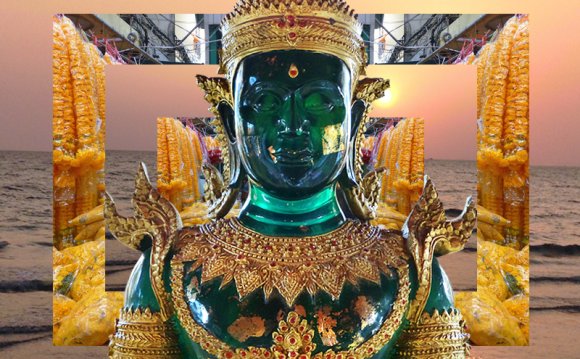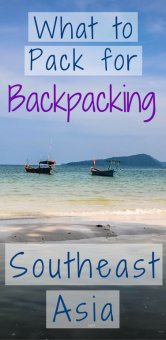
 I’ve read about packing lists ad nauseam on the interwebs. They usually consist of various clothing options and toiletries, but lack the hindsight of someone who has been traveling around with her turtle shell — that would be, my 35L backpack — for the long haul.
I’ve read about packing lists ad nauseam on the interwebs. They usually consist of various clothing options and toiletries, but lack the hindsight of someone who has been traveling around with her turtle shell — that would be, my 35L backpack — for the long haul.
I realize it’s not really that useful to know how many Megan Fox and in-the-tubing tank tops and hippie pants I roll around with, but after four months, you might appreciate knowing what has turned out to be completely essential, and what I ended up ditching during the past four months spent in Cambodia, Laos, and Thailand.
Bring from home:
and
I’ve often found myself in dorms that did not have lockers. When you find yourself in $2 accommodation, sometimes the amenities, as it were, are lacking. In these cases, I find that I have more peace of mind when I can lock up my valuables.
Simply slip the rain jacket that came with your pack over the bag, then slide the Pacsafe over it and lock it.
Plenty of the dorms I’ve been in, as well as the meditation center, did not provide towels. If they did, they charged handsomely for them. My microfiber became very handy to me on many more than just one occasion. Extra points for the quick drying time.
Bank account that doesn’t charge foreign transaction fees and refunds ATM fees
I can use any ATM I want, regardless of the fee the it charges. I don’t have to worry about it, because my bank refunds all ATM fees at the end of the month – even foreign ones. What’s more, I am not charged foreign transaction fees. This amounts to a good $20, minimum, each month that I am saving. That’s a big chunk of change when you consider that $6 is the typical cost of a guest house room in Southeast Asia.
I use Charles Schwab, and have always found them to have great customer service. I’ve heard others say they like using PayPal. Do some searching before embarking on your trip and see what bank could work best for you.
This has been one of the best investments I’ve made (at pretty low cost, at that) in my peace of mind and organization. I don’t have to dig through a mess of clothing to get to anything else in my pack – I simply take the cube in and out as needed and keep dirty clothing on one side, and clean on the other. It also makes it possible for me to be able to fit everything a into a small pack.
tip: roll your clothing and stack side-by-side in the cube to conserve even more space.
Laptop and unlocked phone
If you plan on doing any work from the road, or desire to be connected, watch movies, or save files without relying on internet cafes (and their hours, dingy computers, and gross chairs), bring your own computer. I travel with a 13-inch which takes up very little space and weighs next to nothing. If you don’t have the budget for Apple products, a is a great alternative.
More than that, my has been a God-send. In each country, I buy a cheap SIM card and I’m equipped with 3G, which often works better than wifi. I simply turn my phone into a hot spot, connect my laptop, and BOOM, I’m in business.
Frankly, I was still under contract when I left the states. I put my phone on a $10/month, “maintenance mode” in order to avoid the fee for canceling my two-year contract. If I had not been under contract, I could have easily unlocked my phone for free. Since I was, however, my carrier would not unlock the phone, so I had to use a third party website to the tune of £50 to unlock the darn thing (I’d rather not link them here but if you want the info, feel free to contact me). Still, it has been totally worth it to be connected without paying exorbitant roaming fees to my carrier back home.
Razors, Deodorant, and (ladies only)
It is rather difficult to find Venus razors, Secret Clinical Strength Deodorant (if you’re a sweaty mess like me, which Southeast Asia tends to bring out in people), and the like. Things like soap, Pantene products, and face wash can all be found on the road, but specific items such as the previously mentioned are nearly impossible to find.
Lastly, a diva cup is a helpful investment. It’s a more environmentally friendly and less inconvenient way of dealing with the monthly visitor we ladies have all come to know and loathe.
Travel Insurance
Though healthcare services in Southeast Asia can be cheap for minor issues, if you have an issue SCUBA diving, break a limb while trekking, or come down with an illness like dengue fever (not uncommon in SE Asia and there is nothing you can take to prevent it) and need to be hospitalized, you’re looking at some hefty bills. is not very expensive and can help you get home or to a country with better medical care if you need to. It can also pay for a loved one to come to you.
Buy it there:
Tiger Balm – I foolishly bought this amazing camphor and menthol cream at a specialty store in California for $12, only to find it in Cambodia for $1. It helps ease mosquito bites far better than cortisone cream, and soothes muscle aches.
Clothing – Don’t overdo it and bring too many clothes with you. They are cheap in Southeast Asia and can be found in every night market for just a few dollars. You’ll lose plenty of items to the laundry service (they’ll get lost in the shuffle and you simply won’t notice), holes, or deciding you simply would prefer the cool and different clothing you find on the road to the boring ones from home.
Buy hippie pants without having to agonize over ditching a pair of much more expensive pants from home. Just bring the minimum you need and leave room for cheap purchases on the road. You’ll fare better in the Southeast Asian climate.
Most Toiletries – No need to load up on shampoo and soap. They use these things in Southeast Asia, too.
RELATED VIDEO












